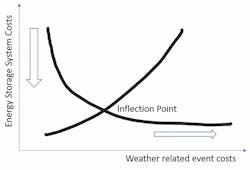About the author:
Rao Konidena is an independent consultant for Rakon Energy. Konidena can be reached at [email protected].
Backup power is one of the benefits provided by energy storage. With hurricanes, floods, and wildfires increasingly occurring, there is a risk of losing power for water pumping stations. Ash from wildfires will get into the water streams that feed the water treatment plants. As a result, this strains the energy grid that provides power to run those water pumping stations and treatment facilities.
Energy storage provides backup power by discharging energy when needed. The cost of energy storage systems is falling due to states like California mandating storage, and increased wind and solar generation on the electric grid. Now is time for cities responsible for water and wastewater treatment plants to leverage this cost reduction and consider energy storage as part of the toolkit to address resiliency and backup power challenges.
Impact of Natural Disasters on Water Infrastructure
Water pumping stations bring water from a source (usually a river) and discharge water into lakes and streams, as an input into water treatment facilities. If water pumping stations do not work, consequences can be fatal as seen from these examples of hurricanes, flooding due to hurricanes and wildfires.
In 2012, during Hurricane Sandy in New York City, “42 of 96 pumping stations that keep storm water, wastewater, or combined sewage moving through the system were temporarily out of service because they were damaged or lost power,” according to the book “Taking Chances: The Coast After Hurricane Sandy.” Similarly in summer of 2019, Hurricane Barry strained the water pumping stations in New Orleans.
Flooding caused damage to the wastewater treatment facilities in South Carolina due to Hurricane Florence in December 2018. The U.S. EPA also cites the March 2010 flooding along the Pawtuxet River in Rhode Island in an “Incident Action Checklist for Flooding”.
Wildfires in Sydney, Australia, in December 2019 are a cause for concern to the local water utility as well. Water New South Wales (NSW) “has put containment barriers to catch potential debris run-off” to avoid wild fire ash-related burnt material getting into the water streams that feed Sydney.
In the western U.S., EPA researchers cite concern that “65% of fresh water supply in the region originates from forested watersheds, which, depending on conditions, can be highly susceptible to forest fires,” according to the agency’s website. Clearly disasters have an impact that should be addressed.
Each year Saint Paul Regional Water Services (SPRWS) estimates it pumps 39 million gallons of water and has a total capacity of 90 million gallons. The Minneapolis Water Treatment Distribution Service (WTDS) estimates it pumps 21 billion gallons of water annually. In terms of energy, this translates to 31,500 MWh of annual energy consumption. On average, for 1 million gallons of water pumped, transported, and distributed, the energy consumed is approximately 1,500 kWh. This number seems small, but when factoring in current and future water needs as well as the number of pumping stations, the energy consumed adds up.
Energy Storage Context
In the past, energy storage at the electric grid-scale was mostly pumped hydro storage or compressed air energy storage in hundreds of mega-watt sizes. If a 100 MW hydro plant discharged energy for four hours, then it is referred to as 400 MWh plant. Mega-watt scale grid storage is changing to smaller size storage units in kilo-watt sizes due to states like California mandating storage both for utility-scale and behind-the-meter categories. Storage for water pumping stations would be in the latter category, behind the utility meter
Higher penetration of renewables — such as wind and solar — need storage to charge when weather allows for production and to discharge when demand is high. Charging from fossil fuels defeats the purpose of having renewables on the electric grid. Battery prices are also falling partly due to increased consumer preference for zero-emission vehicles, and large industrial customers’ desire to lower energy costs by reducing their peak demand charges. This is contributing to more grid-scale battery energy storage in smaller megawatt and larger kilowatt sizes. Lead-acid batteries are no longer the norm. They are making way to Lithium-ion batteries. Lithium Iron Phosphate (LFP, F for Ferrous, which represents Iron) and Nickel Manganese Cobalt (NMC) are popular chemistries for residential storage solutions. Energy storage costs are decreasing, as well.
In 2008, battery costs were as high as $1,000 per kWh. Today the prices are in the range of $100 to $200 per kWh, based on the application. Ultimately, consumers benefit from these lower battery prices because their water utility will not increase water and sewer rates.
WTP Energy Storage Installations
Not everyone thinks about energy storage for water pumping stations. But people who have experienced natural disasters have taken steps to avoid a repeat of their difficulties. The six recent installations below are implementing battery energy storage at their water and wastewater treatment facilities.
1. Irvine Ranch Water District (IRWD) in Irvine, California 40 miles south-east of Los Angeles International Airport is installing 6.25 MW or 35.7 MWh Tesla batteries, owned and operated by Advanced Microgrid Solutions, at water pumping stations, water treatment stations and water recycling plants. The primary driver is the $500,000 energy cost savings per year for the water district.
2. Caldwell Wastewater Treatment Plant in Caldwell, New Jersey, half-hour north-west of Newark International Airport, installed 250 kW/1MWh Eos battery storage with 896 kW of solar for backup power. Here the primary driver is to “keep untreated wastewater from entering local waterways during extended (up to 10 days) power outages,” according to the utility website.
3. Paul R. Noland Wastewater Treatment Facility (east Fayetteville) and the Westside Water Treatment facility in Fayetteville, Arkansas, 200 miles east of Oklahoma City, have recently installed 10 MW of solar and 24 MWh of energy storage. This is a joint project between the Fayetteville, Ozarks Electric Cooperative, and Today’s Power Inc. The primary driver is climate change but there are cost savings of $180,000 per year as well.
4. Village of Wappingers Fall Water Treatment Facility, two hours north of New York City, has a 250 kW, 1000 kWh zinc hybrid cathode battery storage technology for its microgrid. The primary driver here is resiliency and continued operation of this facility.
5. Atlantic County Utilities Authority, 10 miles away from casinos in Atlantic City, New Jersey, is also installing a 1 MW battery energy storage system. The primary driver is eliminating a possible recurrence of raw sewage spilling into New Jersey’s rivers, bays and the ocean.
6. City of Eugene, Oregon, recognized a the benefit of energy storage to provide resiliency at an elementary school, which had been designated for a water well. The well would improve clean drinking water availability during power outages. “This project is also part of EWEB’s long-term resiliency planning efforts to establish community points of water distribution around the city of Eugene to be used by its customers during restoration following a large-scale disaster,” an NEC Energy Solutions press release stated.
The Inflection Point
As the six storage installations at wastewater treatment facilities indicate, we are at an inflection point (see Figure 1 above).
Energy storage system costs are falling at the same time weather-related event costs are increasing. This is the perfect time before experiencing outages for water utilities to proactively budget for backup power at water and wastewater treatment facilities. Energy storage provides that backup power.

